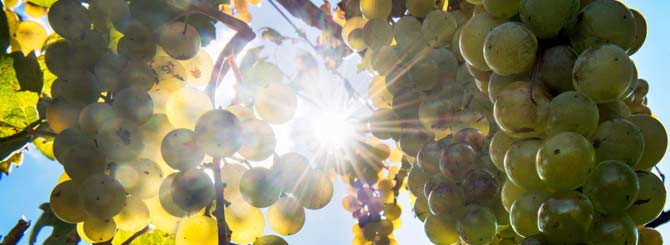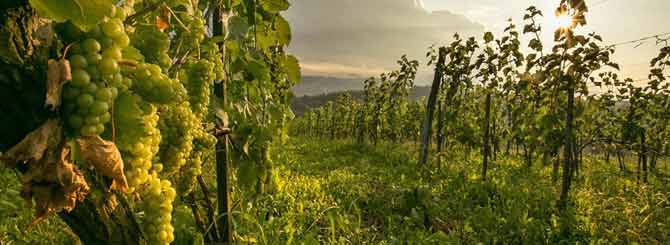Climate Silver Lining for European Wine

"A disaster"; "a grave threat"; the world's viticultural map will be "redrawn"; "cool climate is dead in Old Europe".
Winegrowers, commentators, scientists and winemakers continue to stretch the limits of their vocabulary as the global wine industry grapples with climate change.
The record-breaking heatwave that swept across France in June was the latest reminder that climate change is not a figment of their collective imagination. The Languedoc suffered greatly; over 20,000 hectares of vines in the region were damaged by the intense heat. "It is estimated that production in the Languedoc-Roussillon will fall by between 900,000 and 1 million hectoliters," says Pays d'Oc head of corporate social responsibility Linda Filone.
Summer hail, late-season frost, floods and drought are also occurring with increasing regularity, according to the director.
Yet in a zeitgeist where pessimism about our world's future is as common as overcropped Sauvignon Blanc, a few members of the trade are looking on the bright side. They refuse to accept or endorse the doom mongering, the pessimism and the likely conclusion that our planet is fast approaching a point of no return. In the short term, at least, they believe climate change and rising temperatures have been, and will be good for business.
"I actually feel quite positive about global warming," said Château Lafite's President and CEO Jean-Guillaume Prats, in a Wine-Searcher interview earlier this year.
"The quality of wine in Bordeaux has never been better, and this is due to global warming. People used to harvest in raincoats – now they need t-shirts and sun hats. The last 15 years has seen several extraordinary vintages, so in that sense, global warming has been very positive."
Three months later Bordeaux was sweltering – a timely occurrence as the producer syndicate authorized seven new wine grapes for Bordeaux AOC and Bordeaux Supérieur wines during the summer heatwave.
The seven newly approved Bordeaux grapes include Portugal's Touriga Nacional and Alvarinho, Marselan and Petit Manseng. Meanwhile Linda Filone reports that the Pays d'Oc council is having to invest an unprecedented amount of resources into understanding and combatting climate change.
"The heat wave of June 2019 certainly had irreparable consequences for many vines," says Filone. "There are technologies in constant development; young vines can now be protected by anti-UV sleeves. Agri-vololtaic experiments are underway. These tilting sun shades protect the vine. They aim to reduce vine stress by protecting the bunches at certain key moments, and thus slow down the ripening of the grapes."
Nevertheless, if we accept that the global viticultural map will be redrawn in the next 30 years, southerly regions such as the Languedoc have the most to lose. Do consumers want alcohol levels of 17-18 percent in their Corbières? Should winegrowers start the harvest in July? Reasonable alcohol levels but unsatisfactory phenolic ripeness? And what of Bordeaux? Who fancies Château Margaux 2050 – 80 percent Touriga Nacional, 20 percent Grenache?
Matthieu Bordes, directeur-général at Château Lagrange, concedes that Rhône varieties may one day have a future in the Médoc, although for the moment he remains sanguine about the effects of global warming.
"I am sure that there will be less and less Merlot and more Cabernet Sauvignon and Petit Verdot in the Médoc blends, which is always much better for the wine," says Bordes.
"Lagrange has not been adversely affected by global warming. Honestly, we have benefited from it since 2007 by including more and more Cabernet Sauvignon in the blend. Compared to 20 or 30 years ago, the principal effect of rising temperatures across the Left Bank is Cabernet Sauvignon reaching good maturity every year."
His colleagues in Burgundy are also grappling with unprecedented levels of ripeness and alcohol. Reported alcohol levels of 15 percent following the 2018 harvest prompted Tim Atkin MW to write a feature, questioning whether we were witnessing the death of "elegant Burgundies". Would consumers pay top dollar for Chambertin if it tastes like Napa Pinot, he wondered. I subsequently decided to interview several winemakers across the region about their future, with generally bullish responses to say the least.

"Everybody in Burgundy was very happy, optimistic and serene during the harvest. Perhaps the last vintage with such a high level of quality, such a ripeness and such a volume, altogether, was 1947," said Laurent Delaunay, president of Badet Clement.
"As far as we are concerned, with our own experience of also making high-quality Pinot Noir in Limoux, we know how to adapt to ever warmer conditions. Ultimately, as we do in Limoux, maintaining some elegance and balance may require to look for cooler places (higher altitude, like the hautes-côtes in Burgundy) and plant more adapted clones. But I believe that, even in warmer conditions, and even with reasonably higher alcohol levels, it is possible to keep the elegance and balance that everybody loves in Pinot Noir."
Benjamin Le Berre, CEO of Maison François Martenot, added: "There's less and less chaptalization in Burgundy, or even none at all, so that is going in the right direction. The wines from Burgundy and Beaujolais are therefore more naturally balanced. The winemakers and growers can from now on choose the date to harvest in terms of the maturity of the grapes rather than just because of climatic problems which can ultimately bring about diseases in the vines."
Of course, if consumers react negatively to rising alcohol levels in their prized grand crus, Le Berre might feel differently. However, his point that there have been beneficiaries of global warming in addition to losers is essentially correct.
German Pinot Noir has benefited enormously from the tendency for hotter summers in regions like Pfalz and Rheinhessen. Formerly anemic Spätburgunder now has flesh and muscle on its bones. Moreover, Prats describes global warming as "the catalyst that kickstarted the UK sparkling wine industry". The unprecedented volume of wine produced from the 2018 UK harvest – a dry and hot growing season – is unlikely to be a one-off event.
"The 2018 yields were the highest since inception, however it was only our third harvest," says Ruth Simpson at Simpsons Wine Estate in Kent.
“2018 yields were most definitely the highest, we had over double what we usually would expect on average,” adds Camilla Jennings, head of sales/PR at Jenkyn Place.
"We believe our yields may indeed increase with average annual temperatures, and yet we must realize 2018 was a mixture of many factors (mainly weather) but over the whole 12-month period."
2019 is set to become another standout UK harvest, according to early reports. Investors in Britain are increasingly being joined by copycat pioneers in Scandinavia. Atkin reported in August that Zsuzsanna Barna recently planted 1.5 hectares in Norway, experimenting with Bacchus, Dornfelder, Gewürztraminer, Grüner Veltliner, Pinot Noir, Riesling and Solaris. Two decades ago, such an occurrence would have been regarded as utterly ludicrous.
In addition, Poland is setting its sights to become an internationally recognized producer of quality wine, with the number of vineyards doubling over the past four years.
"Poland is starting to be recognized as a source of quality wine – it's definitely happening," says Warsaw architect Maciej Sondij, co-owner of Dom Bliskowice.
"Dom Bliskowice is already listed in Michelin-starred restaurants in the UK. If other producers follow and listen to their terroir, with time the quality should rise and rise."
Today, there are few respected scientists who have anything positive to say about climate change and rising temperatures.
Already some parts of the world are bearing the brunt, with drought, crop failures, wild fires – Australia and California know all about that – and extreme weather events. In the longer term, things look pretty grim. Holidaymakers should visit the Arctic while they still can.
But it is equally undeniable: some wine regions are doing quite nicely out of global warming. Very nicely indeed.
No comments